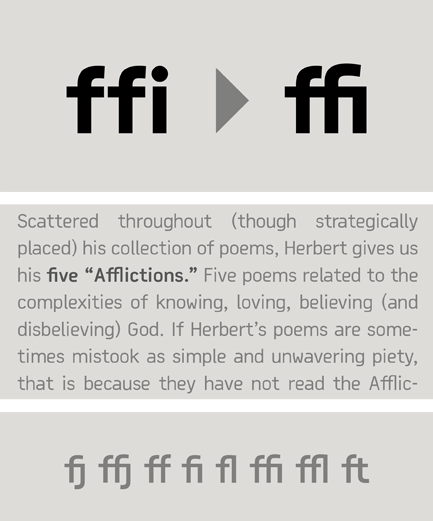








Specimen
Test Driver
Dekka Pro
The origins of Dekka trace back to the original Mac operating system and its standard Monaco font, particularly its outline version called MPW which was designed to be used with the Macintosh Programmer’s Workshop IDE. Dekka though is a refined geometric typeface which was designed to fit typographic requirements.
€585.00 complete family
Dekka Pro
Copyright ©2014
Designer: Panos Vassiliou
The origins of Dekka trace back to the original Mac operating system and its standard Monaco font, particularly its outline version called MPW which was designed to be used with the Macintosh Programmer’s Workshop IDE. Dekka though is a refined geometric typeface which was designed to fit typographic requirements. Its letterforms divert from the stiff mechanical structure of the original and have evolved into curves which are familiar, softer and easier to read. One of its main features is the trimmed diagonal stems/strokes but includes several other distinct characteristics which are reminiscent of the old OCR devices.
Dekka is recommended for branding creative corporate environments, music, fashion, sportswear, technology startups and socially active individuals.
The family consists of 12 weights ranging from Thin to Bold (including true-italics). It provides simultaneous support for Latin, Cyrillic and Greek and is loaded with several advanced typographic features.
Fractions: Figures separated by slash, are replaced with diagonal fractions.

Ligatures: Replaces a sequence of glyphs with a single glyph, creating a professional-looking text with no peculiar collisions among letters. This feature covers the standard f-ligatures, as well as few other ones used in normal conditions.

Oldstyle figures: Changes selected figures from the default lining to oldstyle i.e. numbers of varying height. These are appropriate for use with lowercase text. They come in two different styles: tabular and proportional. Tabular figures have equal widths (useful for tables, so that numbers line
up from one line to the next) whereas proportional have varying widths and are basically used within a sentence.
Lining figures: This feature changes selected figures from oldstyle to the default lining form. Lining figures are numbers which fit better with all-capital text and they are of the same height as capitals or a bit smaller. They also come in two different styles: tabular and proportional.
Proportional figures: Replaces selected figure glyphs which are set on tabular widths (lining or oldstyle), with corresponding glyphs set on proportional widths (lining or oldstyle).
Tabular figures: Replaces selected figure glyphs which are set on proportional widths (lining or oldstyle), with corresponding glyphs set on tabular widths (lining or oldstyle).

Superiors: Replaces lining and oldstyle figures with superior figures and lowercase letters with
superior letters. These superior glyphs are not computer generated scaled-down versions but are rather
redesigned to match the weight of the regular glyphs. Superior figures are used mainly for footnotes
and superior letters for abbreviated titles (this feature includes Latin as well as Greek superior
lowercase and capital letters).
Scientific inferiors: Replaces lining and oldstyle figures with inferior figures. They have been
designed to match the weight of the regular glyphs and sit lower than the standard baseline. Used
primarily for mathematical and chemical notations.

SCRIPTS
1250 Eastern European , 1251 Cyrillic , 1252 Latin 1 , 1253 Greek , 1254 Turkish , 1257 BalticSUPPORTED LANGUAGES
Albanian, Bosnian (Latin), Croatian, Czech, Hungarian, Polish, Romanian, Slovak, Slovenian, Sorbian, Azeri (Cyrillic), Belarusian, Bosnian (Cyrillic), Bulgarian, Kyrgyz, Macedonian (FYROM), Moldovian, Mongolian, Russian, Serbian, Tatar, Ukrainian, Uzbek (Cyrillic), Afrikaans, Alsatian, Basque, Bislama, Breton, Catalan, Chamorro, Danish, Dutch, English, Faroese, Finnish, Flemish, Franco-Provencal, French, Frisian, Friulian, Galician, German, Greenlandic, Icelandic, Indonesian, Irish, Italian, Ladin, Latin, Luxembourgish, Malay, ManxGaelic, Norwegian (Bokmål), Norwegian (Nynorsk), Occitan, Portuguese, Rhaeto-Romance, Romansh, Sami (Inari), Sami (Lule), Sami (Skolt), Sami (Southern), ScottishGaelic, Spanish, Swahili, Swedish, Tagalog, Walloon, Welsh, Greek, Azeri (Latin), Kurdish (Latin), Turkish, Uzbek (Latin), Estonian, Latvian, LithuanianNAME
PF Dekka ProFORMAT
OpenType PSPACKAGE
Family of 12 fonts (also available as separate weights)GLYPHS
751 glyphs /font
PRO FEATURES
Standard f-Ligatures, Oldstyle Figures (tabular/proportional), Lining Figures (tabular/proportional), Proportional Figures, Localized Forms, Scientific Inferiors, Fractions, Numerators / Denominators, Capital spacing, Access All Alternates, Superscript, Slashed Zero
PRICE
family: €585.00
single weight: €65.00















